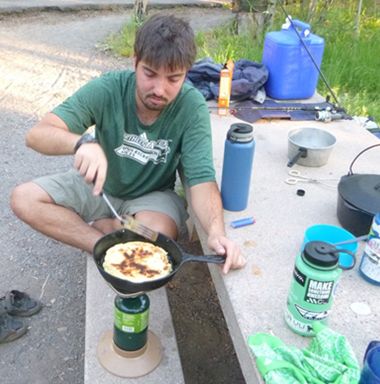
| Articles | Documents | Equipment | Events | Links | Membership | Miscellaneous | Scrapbook | Targets | What's New |
|
Camp Cooking Bannock Bread |
July 2017 | ||
| Bennet Martinez | |||
|
Bannock bread is a type of simple bread often made with a chemical leavening
agent, typically baking powder. It is a simple recipe useful for preparing
in the wilderness. Because it uses baking powder as a leavening agent
instead of yeast for example, it can be made relatively quickly out in the
field.
Bannock bread is also useful since it can be cooked multiple different ways;
most common is probably fried with some oil in a skillet. Other methods
range from baking in the comfort of a kitchen at home to just throwing on
the coals of a fire to make an ash bread.
Early bannock breads were typically made unleavened meaning that no process,
chemical (like baking powder) or biological (like yeast) was added to the
mixture to make the bread fluffy and airy. Modern bannock breads typically
use baking powder to leaven it though it is possible to do the same with yeast.
The origins of bannock bread are difficult to completely track down but the
word itself seems to have Celtic and Scottish origin. The root word may be
traced all the way back to the Latin word panicium which means baked dough.
Bannock bread has similarities with frybread which appears in many different
cultures around the world. Native American made their version of bannock
bread using corn flour and baking on a flat stone without a leavening agent.
It was not until pioneers arrived in the new world that innovations such as
baking with a chemical leavening agent or cooking with cast iron was brought
to the new world. This seems to have developed to the camp food as it is
known today.
Bannock bread can be created a variety of ways depending on personal tastes.
It can be made very simply with just water and flour or it can be made as a
dessert variety with cinnamon and sugar for example. Due to a low water
content, bannock bread is supposed to resist growing mold over time, but
usually it is eaten up before finding this out. One recipe found to work
well for general purposes like supplementing a dinner meal, or a quick and
easy snack in the field, uses the following ingredients:
The dry ingredients are combined in a quart to a gallon sized plastic bag
depending on what is available. This has the benefit of being easy to travel
with until it is time to prepare the bread. Other ingredients can be substituted
to taste such as sugar, cinnamon, cheese, or even nuts and berries.
Once it is time to prepare the bread, water is added directly to the bag for
mixing. There is no exact amount of water, around a third of a cup should be
good, but it is best to go by dough consistency. The dough should have a
roughly Play-dough feel to it. It will not be very elastic like a general
bread dough and will come apart if pulled on.
The dough itself can be cooked in a variety of ways from here. Probably the
most common would be lightly oil a cast iron skillet and fry it up over the
coals of a campfire. This can also be done on a stove, in a Dutch oven, on
a flat rock, or even wrapped around a stick and held over the fire. The bread
should be flipped at least once and be a golden brown color. Enjoy!
© Honeywell Sportsman Club. All rights reserved. | |||
The Honeywell Sportsman Club is a small group of shooting and outdoor enthusiasts in the
Phoenix, Arizona area. Our website is ad-free and completely free to use for everyone.
But we do have expenses that we need to cover, such as the web hosting fee and our liability
insurance. If you enjoyed visiting our website, found it useful in some way, or if you enjoyed
reading this story, please consider tipping us through our PayPal donation jar below. Thanks for visiting, and come back soon.
![]()

Articles
Docs
Eqpt
Events
Join
Links
Misc
New
Pix
Targets



